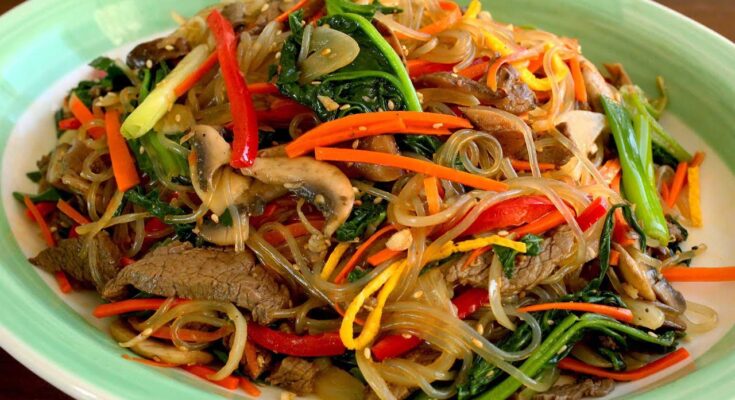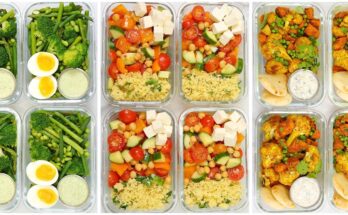Korean Japchae Recipe: Korean cuisine has earned global recognition for its bold flavors, healthy ingredients, and artistic presentation. Among its most iconic dishes, Japchae (잡채) holds a special place. Known for its glossy sweet potato noodles, colorful vegetables, and perfectly seasoned balance of sweet and savory, Japchae is often served during Korean festivals, family gatherings, and celebrations. But the beauty of this dish is that you don’t have to wait for a special occasion—you can make it at home with just a little patience and the right ingredients.
In this guide, you’ll learn exactly how to prepare Japchae step by step, from choosing the freshest ingredients to cooking the noodles perfectly and mixing them into a harmonious dish. By the end, you’ll not only know how to cook Japchae but also understand its cultural significance and how to tweak it to your taste.
What is Japchae?
Japchae, pronounced “jahp-chae,” literally translates to “mixed vegetables” in Korean. It originated during the early 17th century in the Joseon Dynasty and was initially a dish made without noodles, consisting mainly of stir-fried vegetables and seasonings. Over time, the signature sweet potato glass noodles (dangmyeon) were added, creating the chewy, translucent texture that makes Japchae unique today.
The dish is characterized by:
- A glossy appearance thanks to sesame oil.
- A chewy noodle texture that absorbs savory and sweet sauces.
- A colorful combination of vegetables like spinach, carrots, onions, and mushrooms.
- Optional additions of beef, chicken, or tofu, depending on preference.
It’s a dish that balances flavors and textures in a way that feels both comforting and luxurious.
Why Japchae is Loved Worldwide
There’s a reason why Japchae has become a favorite not just in Korea but across the globe. First, it’s incredibly versatile—you can serve it as a side dish (banchan), a main meal, or even pack it for lunch. Second, the dish caters to different diets: it can be easily made vegetarian, vegan, or gluten-free with small adjustments. Finally, Japchae is simply beautiful. The noodles shimmer under sesame oil, and the rainbow of vegetables makes it as visually appealing as it is tasty.
For anyone exploring Korean food for the first time, Japchae is an excellent entry point—it’s approachable, not too spicy, and universally loved.
Ingredients You’ll Need
Cooking Japchae begins with gathering the right ingredients. One of the reasons Japchae tastes so special is the balance between noodles, vegetables, protein, and seasoning. Each component adds its own flavor and texture, and when combined, the dish becomes more than the sum of its parts.
Main Ingredients (Sweet Potato Noodles, Vegetables, Meat)
Sweet Potato Noodles (Dangmyeon)
- These translucent glass noodles are the star of Japchae. Made from sweet potato starch, they are naturally gluten-free and have a delightfully chewy texture. You can find them in most Asian grocery stores.
Vegetables
- Spinach: Adds freshness and a pop of green.
- Carrots: For sweetness and crunch.
- Onions: Bring a mild, caramelized flavor.
- Bell peppers: (optional) for extra color.
- Mushrooms: Shiitake or oyster mushrooms add umami depth.
Protein (Optional)
- Beef (ribeye or sirloin, thinly sliced) is traditional.
- Chicken works well as a lighter option.
- Tofu makes it vegetarian-friendly.
Seasonings and Sauces
The heart of Japchae’s flavor lies in its seasoning. You’ll need:
- Soy sauce: For savory umami.
- Sesame oil: For fragrance and shine.
- Sugar (or honey): To balance the saltiness.
- Garlic: For a punch of flavor.
- Sesame seeds: For garnish and nutty crunch.
Optional Ingredients and Substitutions
One of the best things about Japchae is its flexibility. Don’t have shiitake mushrooms? Use button mushrooms. Want to skip meat? Go vegetarian. Want extra protein? Add an egg garnish (jidan) sliced into thin strips.
You can also swap soy sauce with tamari for a gluten-free version or replace sugar with maple syrup for a healthier twist.
Preparing the Ingredients
Japchae’s magic lies in preparation. Each ingredient is cooked separately before being combined. This ensures that every component retains its texture, color, and flavor. While it may take more time than simply stir-frying everything at once, this step is what makes Japchae taste refined and restaurant-quality.
Prepping the Sweet Potato Noodles
Start by soaking the noodles in warm water for about 30 minutes. This helps soften them before cooking. Once softened, boil them in a large pot of water for 6–7 minutes until they’re chewy but not mushy. Drain immediately, rinse under cold water, and toss with a drizzle of sesame oil to prevent sticking.
Slicing and Preparing Vegetables
- Spinach: Blanch briefly in boiling water, then squeeze out excess water and season with a little sesame oil and salt.
- Carrots and onions: Slice into thin matchsticks for even cooking.
- Mushrooms: Slice thinly for quicker stir-frying.
- Bell peppers: If using, cut into thin strips for color.
Preparing the Meat or Vegetarian Alternatives
If you’re using beef or chicken, slice it thinly and marinate in a mixture of soy sauce, garlic, sugar, and sesame oil for at least 15 minutes. For tofu, pan-fry until golden on all sides before adding it to the mix.
This step ensures that your protein is flavorful and integrates well with the noodles and vegetables.
Step-by-Step Cooking Guide
Now comes the fun part—bringing everything together. Japchae is all about layering flavors, and each step is crucial for the final taste.
Cooking the Noodles Perfectly
After boiling and rinsing your sweet potato noodles, season them lightly with soy sauce and sesame oil. This step ensures that even the noodles alone are flavorful.
Stir-Frying Vegetables for Maximum Flavor
Heat a pan with sesame oil and stir-fry each vegetable separately. Yes, separately. This prevents overcrowding and allows each vegetable to shine—spinach stays green, carrots keep their crunch, and mushrooms maintain their umami flavor.
Cooking the Meat (or Skipping for Vegetarian)
Cook your marinated beef or chicken until just tender, then set aside. If using tofu, pan-fry until golden before mixing.
Mixing Everything Together
Once all components are ready, combine them in a large mixing bowl or wok. Toss gently with soy sauce, sesame oil, sugar, and garlic. The key here is balance—nothing should overpower the other. Finish with toasted sesame seeds.
Tips for the Best Japchae
Cooking Japchae is simple, but a few insider tips can take it from good to unforgettable.
Common Mistakes to Avoid
- Overcooking noodles – they should be chewy, not mushy.
- Cooking vegetables together – this causes sogginess and uneven textures.
- Skipping the seasoning of each layer – Japchae’s magic is in layering flavors, so season lightly at every step.
Flavor Variations and Add-ons
Want a spicier Japchae? Add a spoonful of gochujang (Korean chili paste). Prefer a lighter version? Use less oil and add more greens. You can even experiment with zucchini, asparagus, or broccoli for a modern twist.
Making Japchae Ahead of Time
Japchae actually tastes better after sitting for a while because the noodles absorb more flavor. You can prepare it a few hours ahead of serving, making it perfect for parties.
Serving Suggestions
Japchae is a versatile dish that can be served in many ways depending on the occasion. Whether you’re preparing a family dinner, a festive celebration, or even a simple lunch, Japchae adapts beautifully to different dining settings.
How to Serve Japchae Traditionally
In Korea, Japchae is often served as part of a larger banchan spread (small side dishes) during holidays and family gatherings. On important occasions like Lunar New Year (Seollal) or the Harvest Festival (Chuseok), Japchae is a must-have on the table. It’s usually placed in a large serving platter at the center, allowing everyone to help themselves.
Traditionally, Japchae is enjoyed at room temperature. Unlike most noodle dishes that are eaten piping hot, Japchae’s flavors shine when it has cooled slightly, allowing the seasonings to meld together. The glossy sheen of sesame oil makes it look as good as it tastes.
Modern Twists and Pairings
In modern kitchens, Japchae has gone beyond tradition. You’ll find it:
- As a main dish: With added protein like beef, chicken, or tofu, Japchae can easily stand alone as a meal.
- In lunchboxes (dosirak): It makes an excellent lunch because it doesn’t become soggy quickly.
- As party food: Its colorful presentation makes it a crowd-pleaser at buffets and potlucks.
Pair Japchae with other Korean favorites like kimchi, bulgogi, or Korean fried chicken. For drinks, it goes surprisingly well with Korean rice wine (makgeolli) or even a crisp white wine.
Nutritional Value of Japchae
Japchae is more than just delicious—it’s also packed with nutrition, thanks to its variety of fresh vegetables and lean protein.
Health Benefits of Ingredients
- Sweet Potato Noodles: Unlike wheat-based noodles, they are gluten-free and lower in calories. Their chewy texture also makes them more filling.
- Spinach: High in iron, calcium, and vitamins A and C.
- Carrots: Provide beta-carotene, good for vision and skin.
- Mushrooms: Rich in antioxidants and a natural umami booster.
- Sesame oil: Adds healthy fats that support heart health.
When combined, Japchae becomes a well-balanced dish that includes carbohydrates, protein, fiber, and healthy fats.
Calories and Macros Breakdown
A standard serving of Japchae (about 1 cup) provides approximately:
- Calories: 250–300
- Protein: 6–10g (depending on meat or tofu added)
- Carbohydrates: 40–45g
- Fat: 8–12g
Of course, the nutritional value changes depending on the portion size and the amount of oil, sugar, or meat you use. To make Japchae lighter, reduce the oil and use lean protein like chicken breast or tofu.
Storage and Reheating
Japchae is one of those dishes that tastes just as good the next day—if stored properly.
How to Store Japchae Properly
- Refrigeration: Store Japchae in an airtight container in the fridge. It will keep well for 3–4 days.
- Freezing: Technically, you can freeze Japchae, but the texture of the noodles may suffer. If you do freeze it, store it in a freezer-safe container and consume within a month.
Best Ways to Reheat Without Losing Flavor
- Stovetop: Heat a non-stick pan with a drizzle of sesame oil and stir-fry until warmed through. This method keeps the noodles chewy.
- Microwave: Quick and convenient, but the noodles may become a bit soft. Cover with a damp paper towel to prevent drying out.
- Room Temperature: If you prefer, simply bring it out of the fridge and let it sit for 20–30 minutes before serving. Japchae is delicious at room temperature.
FAQs about Korean Japchae Recipe
1. Can Japchae be made vegan?
Yes! Simply skip the meat and add extra tofu or mushrooms. The dish will still be flavorful and satisfying.
2. Can I use glass noodles instead of sweet potato noodles?
While other glass noodles can work, authentic Japchae is made with sweet potato noodles (dangmyeon). They provide the chewy texture that makes the dish unique.
3. How long does Japchae last in the fridge?
Japchae can be stored in an airtight container in the fridge for up to 3–4 days.
4. Can I freeze Japchae?
You can freeze it, but the noodles may lose their chewy texture. It’s best enjoyed fresh or within a few days of making.
5. What meat is best for Japchae?
Traditionally, thinly sliced beef (like ribeye or sirloin) is used. However, chicken, pork, or even shrimp work well as alternatives.
Conclusion
Japchae is more than just a Korean noodle dish—it’s a celebration of flavor, color, and tradition. With its glossy sweet potato noodles, perfectly seasoned vegetables, and versatility to suit any diet, Japchae is a recipe worth mastering. Whether you’re cooking for a family dinner, a festive holiday, or a casual get-together, Japchae will always shine on the table.
By following this step-by-step Japchae recipe, you’ll be able to recreate an authentic Korean classic right in your own kitchen. Don’t rush the process—take time to cook each ingredient separately, season carefully, and let the flavors marry together. The result? A dish that’s comforting, nutritious, and utterly delicious.



